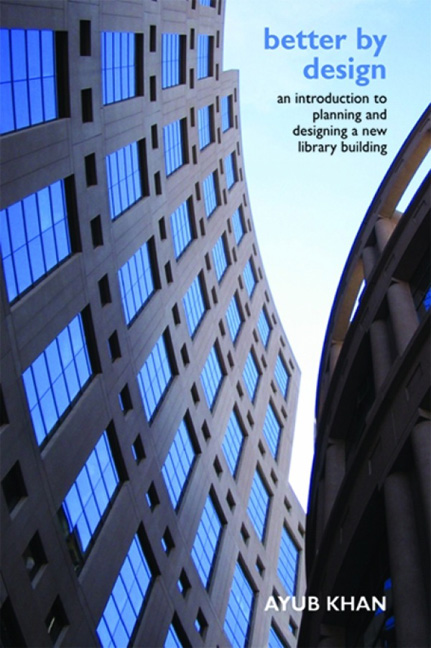Book contents
- Frontmatter
- Dedication
- Contents
- Lists of figures and tables
- Preface
- Acknowledgements
- Abbreviations and technical terms
- 1 Introduction
- 2 21st-century libraries
- 3 Developing a business case
- 4 Project management
- 5 The design/project team
- 6 Selecting an architect
- 7 Partnership and community engagement
- 8 The design brief
- 9 Design quality
- 10 Space planning and access
- 11 Occupancy and post-occupancy evaluation
- 12 Building libraries for the future – a summary
- Bibliography and further reading
- Appendices
- Appendix 1 Glossary (including common terms used within the construction/building environment)
- Appendix 2 Ambience – discussion checklist for librarians and architects
- Appendix 3 Top ten tips
- Appendix 4 Space adjacencies diagram
- Index
- Miscellaneous Endmatter
- Miscellaneous Endmatter
- Miscellaneous Endmatter
- Miscellaneous Endmatter
Appendix 2 - Ambience – discussion checklist for librarians and architects
from Appendices
Published online by Cambridge University Press: 08 June 2018
- Frontmatter
- Dedication
- Contents
- Lists of figures and tables
- Preface
- Acknowledgements
- Abbreviations and technical terms
- 1 Introduction
- 2 21st-century libraries
- 3 Developing a business case
- 4 Project management
- 5 The design/project team
- 6 Selecting an architect
- 7 Partnership and community engagement
- 8 The design brief
- 9 Design quality
- 10 Space planning and access
- 11 Occupancy and post-occupancy evaluation
- 12 Building libraries for the future – a summary
- Bibliography and further reading
- Appendices
- Appendix 1 Glossary (including common terms used within the construction/building environment)
- Appendix 2 Ambience – discussion checklist for librarians and architects
- Appendix 3 Top ten tips
- Appendix 4 Space adjacencies diagram
- Index
- Miscellaneous Endmatter
- Miscellaneous Endmatter
- Miscellaneous Endmatter
- Miscellaneous Endmatter
Summary
Modernization of libraries
■ image of library service and marketing/consultation
■ design – responding to lifestyle change
■ resources and services
■ staff skills and customer care
■ buildings/facilities/presentation and layout
■ retail approach to be adopted, for example:
— bookshops that display and sell books
— other retail responses to market forces and leisure retailers (like Nike, Apple stores) with a wider product range than bookshops
– rather like libraries
— other sectors that libraries can refer to, in addition to retail, for example sports, health
Inside the library
■ how the layout and presentation could hinder or help
■ how design improvements could be made, e.g.:
— need to circulate clockwise
— use of open spaces
Entrance areas
■ systems and procedures before products and services
■ passages and corridors
■ posters or plasma screen
■ presumption of confidence and familiarity
■ vestiges of ‘no entry without a ticket’ attitude
■ restriction of spontaneity
■ entrance area as event or performance space
Reception/greeting points
■ impressions
■ size and function of counters – for customers or storage?
■ windbreaks and screens
■ alternatives
Sight lines
■ being able to see where users are going
■ establishing clear sight lines
■ gathering points
■ staff availability for help
Creating space
■ a fresh assessment of time-honoured use
■ examining what is flexible in the building's structure
Use of space
■ arriving
■ learning
■ studying
■ privacy
■ browsing – new groupings/arrangements of stock
■ reading and relaxing/resting
■ information
■ younger children
■ older children/young adults
■ different ambiences for different spaces
■ positioning of different spaces
■ events and activities
■ public art
Guiding
■ clear/flexible
■ visible
■ attractive and dyslexia friendly – mix of very visible text and images
■ house style
Furniture
■ interior design ideas in support of use of space
■ presentation of posters/leaflets
■ displays
■ replacement
■ group seating
■ study
■ sofa/easy chairs
Shelving
■ mobility and flexibility
■ open/closed access
■ age groups
■ disability
Equipment
■ PCs
■ photocopier
■ baskets and personal trolleys
Facilities
■ refreshments/café
■ vending area
■ use of mobile phones
Colour and images
■ reflecting diversity
■ community of interest
■ overall style to complement space/purpose
Lighting schemes
■ variable/flexible
Events and activities
■ transforming space for events and performances
Information
- Type
- Chapter
- Information
- Better by Designan introduction to planning and designing a new library building, pp. 179 - 182Publisher: FacetPrint publication year: 2008
